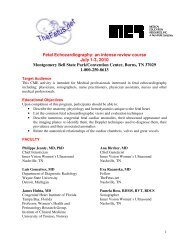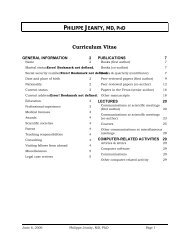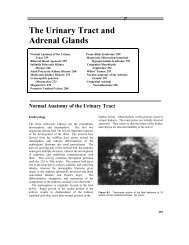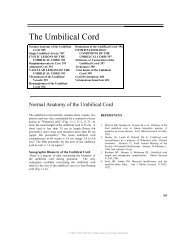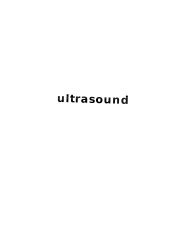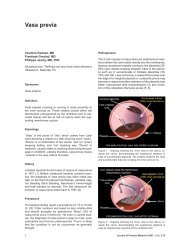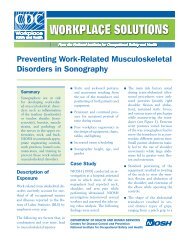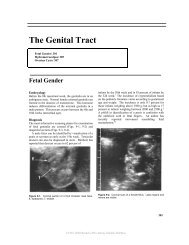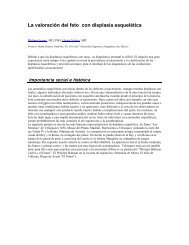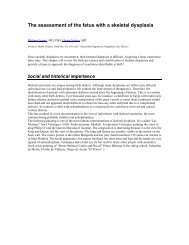Conjoined Twins: Developmental Malformations and ... - SonoWorld
Conjoined Twins: Developmental Malformations and ... - SonoWorld
Conjoined Twins: Developmental Malformations and ... - SonoWorld
Create successful ePaper yourself
Turn your PDF publications into a flip-book with our unique Google optimized e-Paper software.
<strong>Conjoined</strong> <strong>Twins</strong>: <strong>Developmental</strong> <strong>Malformations</strong> <strong>and</strong> Clinical Implications<br />
The embryological theory of the author is that all conjoined twins result from fusion of separate germ<br />
discs. This is presented with an evangelistic zeal that betrays a lack of objectivity, with few qualifications<br />
or expressions of doubt. She assumes that all patterns <strong>and</strong> degrees of twinning are due to the same<br />
mechanism, <strong>and</strong> that fusion <strong>and</strong> fission are the only two mechanisms requiring consideration, so that<br />
disproof of one proves the other. Concepts that might apply to some cases are applied universally. For<br />
example, on page 416, the author expresses without qualification the opinion that teratomas are parasitic<br />
conjoined twins.<br />
Her discussion of the theoretical embryology of "parapagus" twinning (pages 246-247) provides a<br />
particularly disturbing example of fundamental convictions based upon unconvincing evidence. She<br />
dismisses fission as the mechanism of rostral duplications in the following words:<br />
Bifurcation of a single notochord has been proposed (Machin <strong>and</strong> Sperber, 1991), but as<br />
the notochord probably elongates by proliferation at the caudal aspect (O'Rahilly, 1998),<br />
bifurcation during growth should result in caudal, not cranial duplication [italics mine].<br />
The implied support of a leading authority on embryology lends an aura of respectability to this<br />
statement. However, the only reference provided is to a personal communication, <strong>and</strong> the adverb<br />
"probably" seems to be given the status of certainty. That statement constitutes one of two chief<br />
arguments offered as proof that "parapagus" twinning results from fusion of originally separate germ<br />
discs. The other argument is presented in the following words (p. 246):<br />
In a review of the entire spectrum of parapagus—it might seem logical to assume that they<br />
arise from two separate, nearly parallel notochords on one embryonic disc, very close<br />
together caudally but with varying degrees of separation rostrally. However, secondary fusion<br />
of two separate embryonic discs is indicated by the indisputable evidence of duplication of<br />
some portion of the umbilicus, umbilical cord, or placenta in a few parapagus [italics mine].<br />
The reasons why these few "indisputable" cases so conclusively prove her point are not explained<br />
further. No details are provided concerning these cases, <strong>and</strong> I searched in vain for reference to where<br />
they were published. On page 254, it is mentioned that these cases comprised 2% (i.e., 6) of her 305 pairs<br />
of "parapagus" twins. On page 246, it is mentioned that three of them were characterized by "an<br />
additional umbilical vessel," without noting whether these were arteries or veins, or how their number<br />
was documented. Accessory umbilical vessels can result from several developmental mechanisms other<br />
than fusion of separate embryonic discs. These six "indisputable" cases, plus the aforementioned<br />
reference to a statement by Dr. O'Rahilly, are considered sufficient to justify the following sweeping<br />
generalization (p. 246):<br />
All things considered, then, it is postulated that all conjoined twins, including the<br />
parapagus, arise from two individual notochords on two originally separate embryonic<br />
discs [italics mine].<br />
http://link.springer-ny.com/link/service/journals/10024/contents/03/4038/paper/body.html (2 of 5) [9/9/2003 11:23:52 AM]



